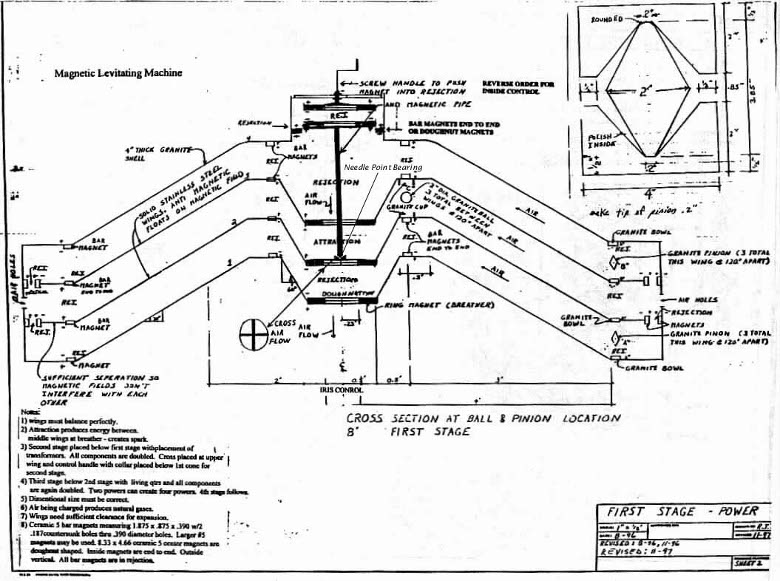The complete ship is actually built as three stages. The first stage is usually refered to as the motor and is what most of this page details. At the bottom are a few pictures dealing with the second stage. All magnets are ceramic magnets.
Before my first contact with David Hamel I tried to build my own smaller and cheaper version of the motor component (first stage) by roughly following Pierre Sinclaire's blueprints.
Everything that I write here will have been told to me by David Hamel. I will try very hard to make sure that nothing is invented by me.
First Stage
The first stage is analagous to the ionoshere as it is in that stage that the ions are produced. The second stage is analagous to the stratosphere since the air within this stage is thin and it is hard to breath. The third stage is analagous to sea level and that is where the passengers will live. The previous motor that David had built that flew away was equivalent to the first stage (or motor).
The motor consists of a top, two semi-free floating wings and a base. The top and the base are fixed in place. The wings are floating on and are somewhat restricted by ceramic magnets but are also restricted in how far they can move through the use of balls and pinions. As you can see by the diagram there are three granite balls spaced 120 degrees apart between the two wings. A picture of one of the balls can also be found below. There are six granite pinions altogether spaced 120 degrees apart. There are three pinions between the top and the top wing and there are three pinions between the base and the bottom wing. See the diagram and pictures below for more on the pinions.
|
|
|
Some additional drawings, photos of David's construction and photo's of Tracy Jone's efforts can be found here. (look for links labeled HFS or Hamel Flying Saucer).
Click on the small images to see larger versions.
|
|
Blueprint drawn by Bob Thomas of the first stage and part of the second |
Rejection magnets
Top of motor
|
|
Closeup looking down of the cone that will be a part of the top. |
|
|
Side view of the cone that will be a part of the top. |
Top wing (i.e. first wing from the top)
|
|
A view of a pinion sitting in its cup in the rim of the top wing. |
Bottom wing (i.e. second wing from the top)
|
|
This is looking up underneath the bottom wing. The cross can be seen at the bottom of the cone. This is what the rod in the picture above will be sitting in and moving. |
|
|
This shows a ball sitting in its cup. This ball will restrict the movement of the wings with respeect to each other. In the background David can be seen explaining something to Ole. |
|
|
The cup for a pinion. |
Base
Note that on this day the base was sitting upside down outside so keep that in mind as you look through these pictures.
|
|
The base sitting upside down outside. |
|
|
The underside of the base. It is through the center hole that you see that the air returns. Dan LaRochelle refers to this is as the "1st Stage Vortex Return". |
|
|
|
|
|
I should have turned my camera upside down. This is a picture of the top of the base. |
|
|
Sitting on the floor is the rim that still needs to be attached to the base as well as a ring of ceramic magnets for repelling one of the two wings' rim-magnets. |



